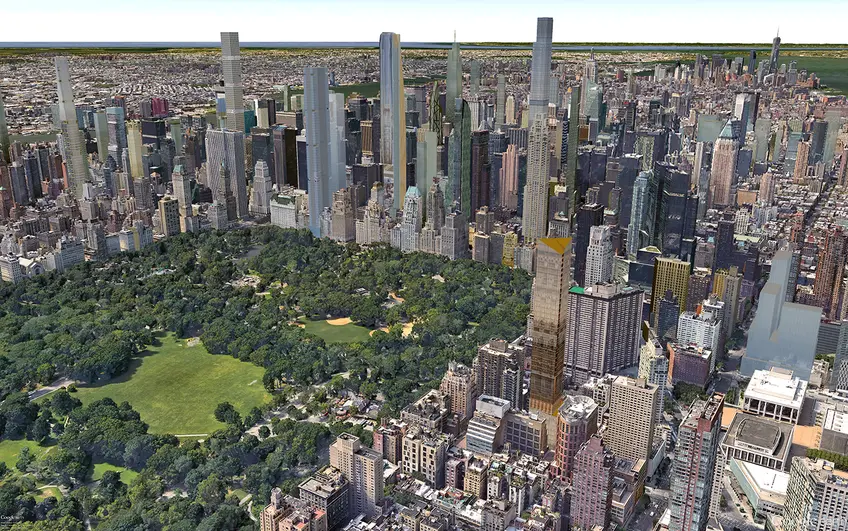 50 West 66th Street and Midtown's future skyline (CityRealty)
50 West 66th Street and Midtown's future skyline (CityRealty)
Extell Development Company is planning a 775-foot-high residential tower with some rakish angles and chamfered balconies at 50 West 66th Street that will be designed by Snohetta, the architectural firm that created the slanted September 11 memorial museum at the World Trade Center site.
The tower, which would become the tallest on the Upper West Side, will contain 127 condominium apartments.
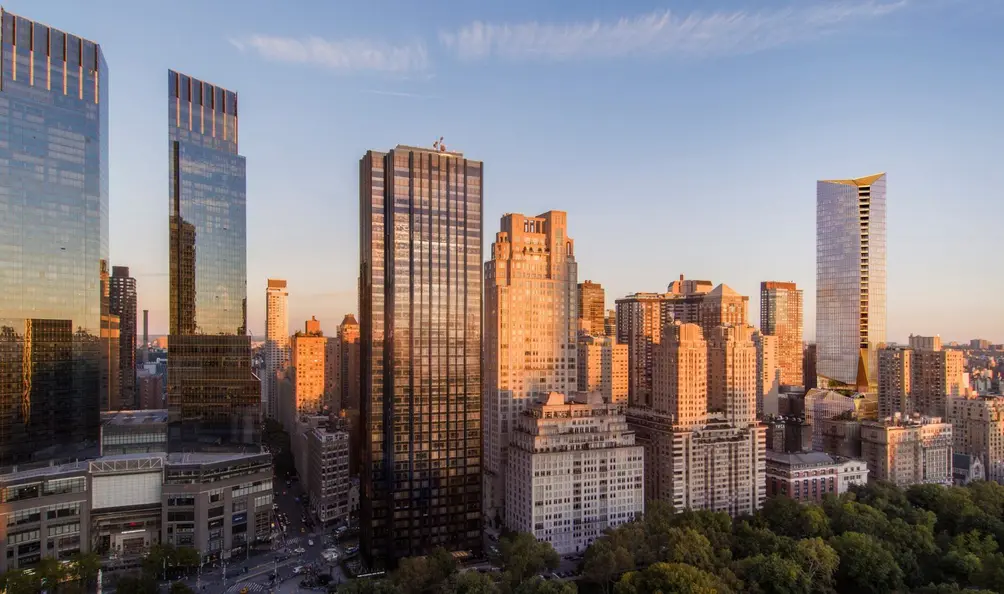 (Credit: Snohetta)
(Credit: Snohetta)
In this article:
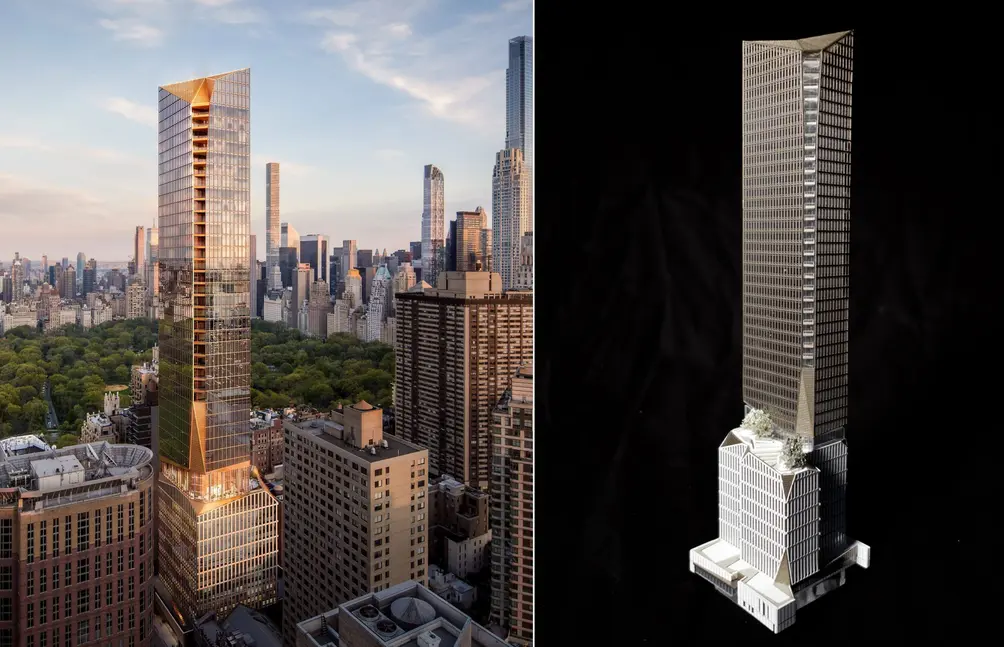 (Credit: Snohetta)
(Credit: Snohetta)
It utilizes air rights from the Jewish Guild for the Blind at 15 West 66th Street that were acquired this week by Extell for about $147 million. Extell also closed on another $55 million in air rights from Disney with its development partner, Megalith Capital, which bought three commercial buildings from Disney on 66th Street in 2014, according to an article at therealdeal.com by Will Parker.
The mid-block site runs through the block to 65th Street and its base there will have a synagogue. The site is adjacent to the First Battery Armory building, which is an individual city landmark, but the site of the planned tower is just outside the boundaries of the Upper West Side/Central Park West Historic District.
The mid-block site runs through the block to 65th Street and its base there will have a synagogue. The site is adjacent to the First Battery Armory building, which is an individual city landmark, but the site of the planned tower is just outside the boundaries of the Upper West Side/Central Park West Historic District.
 (CItyRealty)
(CItyRealty)
 Digging at the site as of early October (CityRealty)
Digging at the site as of early October (CityRealty)
The tower will be setback atop a broad base with protruding tall windows on a slopping, landscaped south terrace with a very grand, broad and angled staircase. This terrace slopes upward from the east at about the same substantial angled that the base of the tower slopes downward from the west.
The angularity of the terrace is repeated with the stepped and angled roofline of the base and that angularity is also employed on the roof the tower, which is an asymmetrical shape further complicated by the slightly spreading width of the two corner balcony chamfers that terminate in 6-story, solid, triangular, bronze sheets.
The fenestration pattern of the tower is much less articulated than the base as its slender bronze mullions and spandrels recall the elegant grid at the Seagram Building to a good extent.
The base of the tower rises dramatically toward the west in much the same manner as Kohn Pedersen Fox’s One Vanderbilt tower on 42nd Street rises as it approaches the west façade of Grand Central Terminal.
Such cleavage can be sexy for some, but just gimmicky for others. It is perhaps interesting when inside when the angling begins to be explosive. When considered from the outside, however, it hints of imbalance and Jaws!
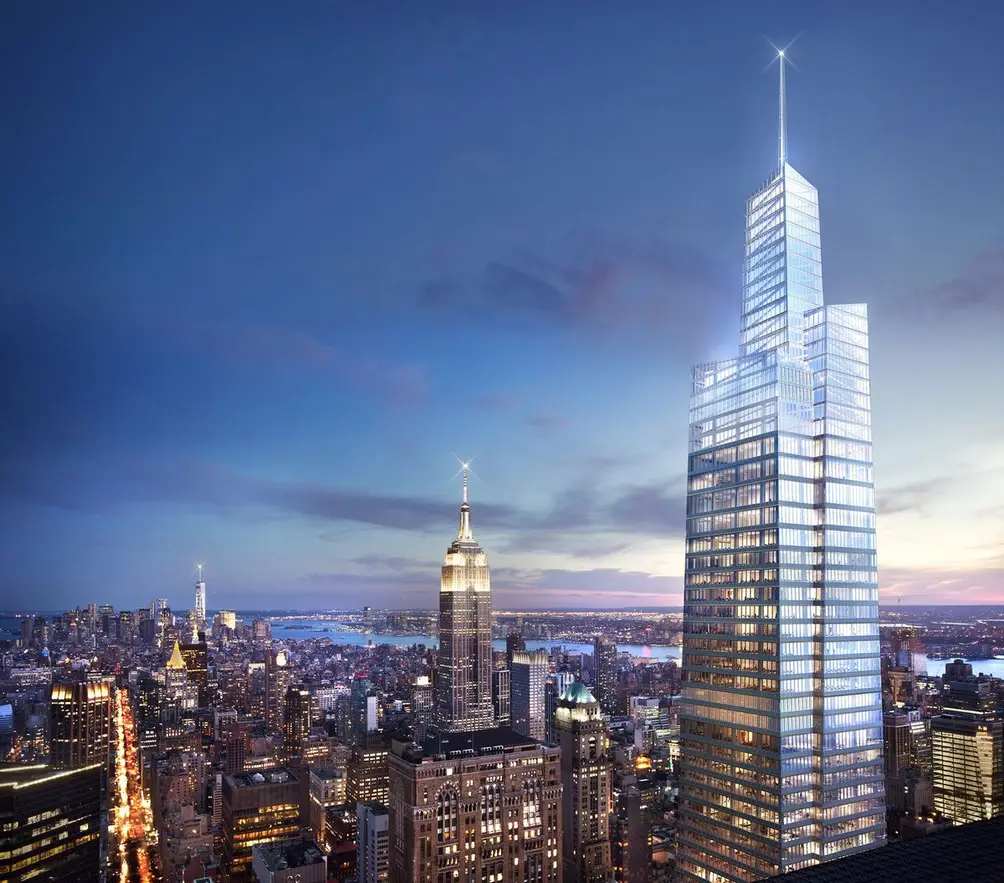 Rendering of One Vanderbilt (KPF)
Rendering of One Vanderbilt (KPF)
The tapering One Vanderbilt, of course, is a much taller project that will rise several hundred feet higher than the nearby Chrysler Building, the city’s most glorious top and both it and the Extell tower on 66th Street are unwieldy and ungainly, but at least the Extell tower is more elegant and interesting and somewhat more compatible with its important neighbors.
The Extell tower has a passing resemblance to Kohn Pedersen Fox’s reflective-glass tower at Hudson Yards for the Related Cos., which also has a chamfered corner and a rakish top, though no grand staircase. (It is not far, however, from Related’s 15-story, staircase folly, “Vessel,” by Thomas Heatherwick, the bronze centerpiece of its main plaza at Hudson Yards.)
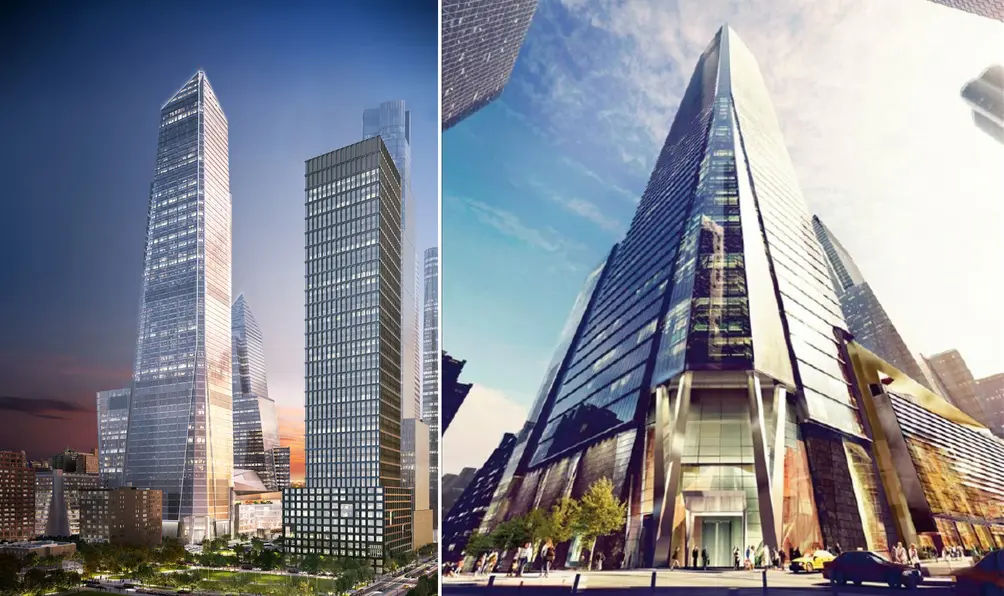 30 Hudson Yards (KPF)
30 Hudson Yards (KPF)
According to Mr. Parker’s article, the Extell tower’s chamfers are, according to a press release, “cutaways ‘evocative of the chiseled stone of Manhattan’s geologic legacy.’” That may be true if one is rummaging about in Central Park transverse roads, but such a legacy is a bit rarefied, although chamfers seem to be becoming quite popular these days.
The notion of cutaways and chamfers and shards imply a daring sense of instability that conjures “Leaning Tower of Pisa” syndrome that is certain to attract more tourists to the Lincoln Center/Columbus Circle domain where neck-craning is soon to become widespread as Extell’s glassy, 1,550-foot-high Central Park Tower, designed by Adrian Smith + Gordon Gill, continues to soar upwards way beyond Robert A. M. Stern’s elegant, 950-foot-tall limestone pinnacle at 220 Central Park South.
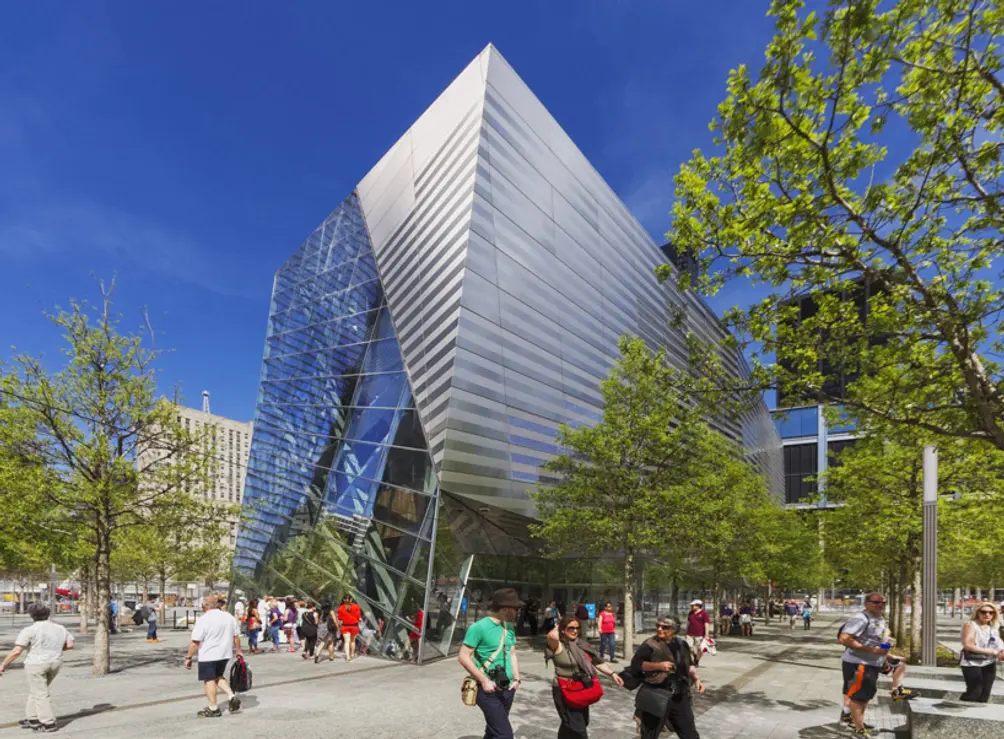 September 11 Memorial Museum Pavillion (Credit Jeff Goldberg/Esto Snohetta
September 11 Memorial Museum Pavillion (Credit Jeff Goldberg/Esto Snohetta
Snohetta’s National September 11 Memorial Museum at the World Trade Center was completed in 2014, thirteen years after the terrorist attack left the site littered with just a few structural tritons, two of which are memorably contained in the marvelously a-kilter museum.
Snohetta’s next finished its fortress-like, San Francisco Museum of Modern Art Expansion in 2016 and its “eastern façade, inspired in part by the waters of the San Francisco Bay, comprises more than 700 uniquely shaped FRP (fiberglass reinforced polymer) panels affixed to a curtain-wall system to create rippling horizontal bands,” according to the firm’s website, adding that “Silicate crystals from Monterey Bay embedded in the surfaces of the panels catch the changing light and cause the façade to shift in appearance throughout the day.”
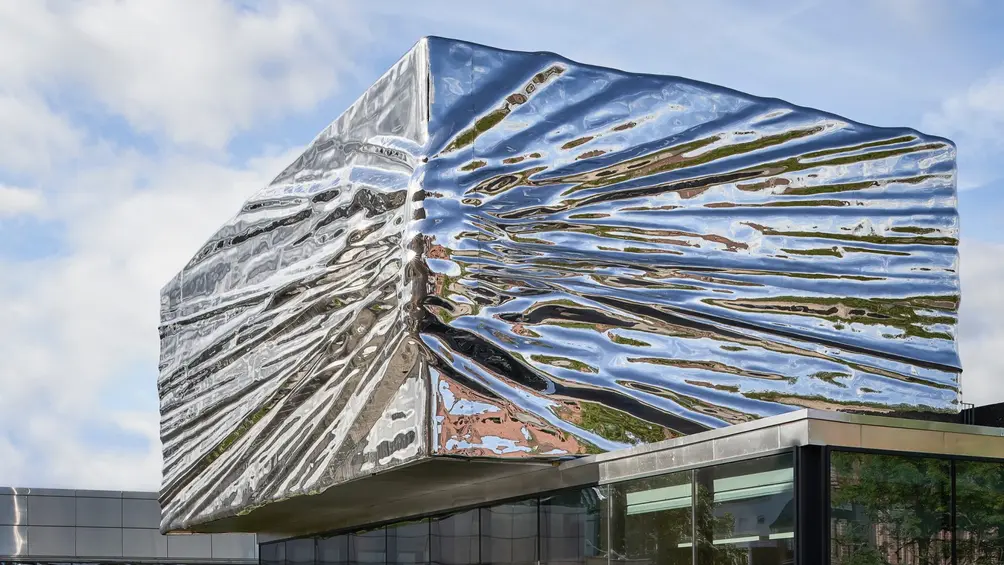 Lillehammer Art Museum and Cinema (Snohetta)
Lillehammer Art Museum and Cinema (Snohetta)
Also in 2016, the firm completed its stunning “melting ice-cube” cinema expansion for the Lillehammer Art Museum and its “striking metallic wrapping reflects the surrounding context and changes its appearance with the light,” the website noted, adding that “the façade was created by late Norwegian artist Bård Breivik (1948-2016), and it is conceptually rooted in the sculptural idea of a shooting star, a dramatic symbol of the importance of Weidemann’s contribution to Norwegian painting. The façade is made from driven, highly polished stainless steel, with reliefs at approximately 25cm deep.”
Not all of the firm’s projects have met with applause.
Its plan to redo the pink granite base of the AT&T/Sony tower on Madison Avenue between 55th and 56th Street whose “Chippendale” top designed by Philip Johnson met with considerable protest and Tuesday the Landmarks Preservation Commission announced it would hold a hearing on designating the building’s exterior as a landmark.
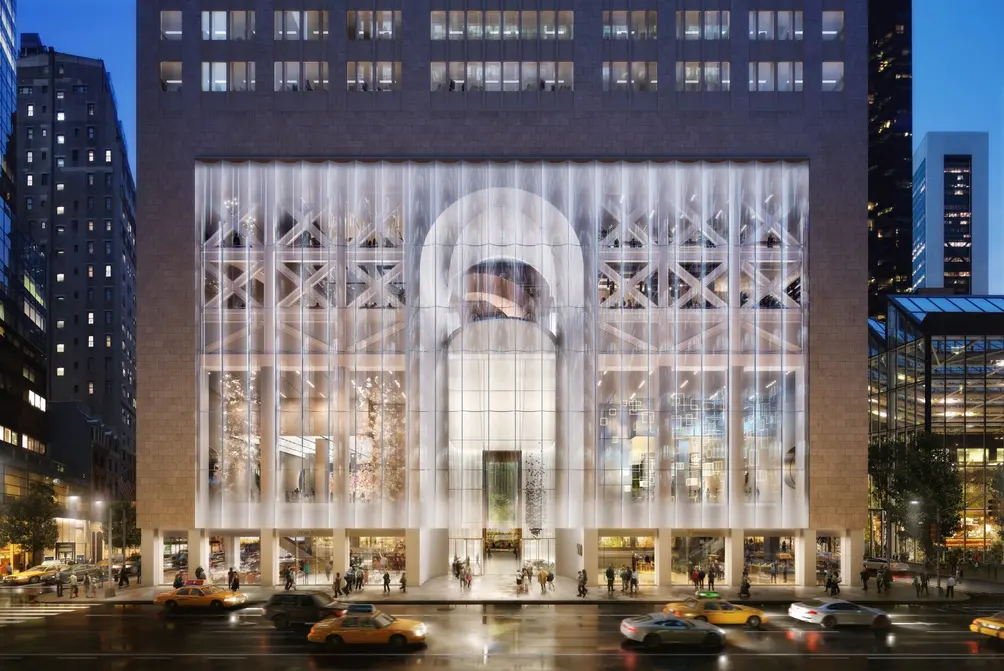 Rendering of 550 Madison Avenue, via DBOX/ Snohetta
Rendering of 550 Madison Avenue, via DBOX/ Snohetta
The Snohetta plan would replace much of the base’s frontage with an undulating glass curtain wall revealing its X-shaped steel bracing around its very tall entrance that originally housed the gilded and very spectacular Spirit of Communication statue by Evelyn Beatrice Longham that originally capped the A. T. & T. Building on Broadway at Fulton Street. When A. T. & T. relocated to New Jersey, it took the statue with it. Later it offered it back to the city but the city, incredibly, turned the offer down and A. T. & T. then took it Dallas to decorate its new corporate quarters.
New York should bring the statue back, somehow!
New York should bring the statue back, somehow!
 50 West 66th Street will be the tallest building ont the Upper West Side(CityRealty)
50 West 66th Street will be the tallest building ont the Upper West Side(CityRealty)
Would you like to tour any of these properties?

Architecture Critic
Carter Horsley
Since 1997, Carter B. Horsley has been the editorial director of CityRealty. He began his journalistic career at The New York Times in 1961 where he spent 26 years as a reporter specializing in real estate & architectural news. In 1987, he became the architecture critic and real estate editor of The New York Post.


 6sqft delivers the latest on real estate, architecture, and design, straight from New York City.
6sqft delivers the latest on real estate, architecture, and design, straight from New York City.
